Dragonflies
Dragonfly or Damselfly Both groups have very long abdomens, two pairs of wings and both are predators. Dragonflies are large and have a stout build; damselflies are smaller and have a slight build. The eyes of many dragonflies touch in the centre, the damselfly’s are far apart. The damselfly usually rests with its wings along its body, the dragonfly with its wings spread to either side.
The dragonfly, albeit harmless and even beneficial to people, looks sufficiently fearsome that it has been overlain with myths which variously claim that it: bites, is poisonous, predicts storms, helps (or hinders) fishing, stitches one’s fingers, toes, eyelids or whatever, is the devil incarnate, and so forth. This is an amazing burden of nonsense to have been applied to such a delightful little creature.
Mind you, the dragonfly is a voracious predator and it captures live prey on the wing. Its hunting prowess owes much to its large eyes, maneuverable flight, barbed legs used to cage prey, and powerful jaws. It has been known to take down a humming bird, but normally feasts on flies, mosquitoes, beetles, and even bees.
Watching dragonflies patrol the shoreline is one of the delights of a summer’s visit to the beach. Three species are likely to be seen along the non-marshy portions of the Lake: two darners and a clubtail. The darners are easily distinguished from the clubtail, but the differences between the darners is subtle. Less often one sees a whitetail.
Darners, characteristics shared by Shadow and Paddle-tailed.
The eyes of the darner touch along a long central line. The male is black and blue with some yellow; the female is black and brown with some yellow. The Shadow Darner (particularly the male) restlessly patrols the shoreline in search of food and a mate, so it is usually flying when encountered. It is the more common of the two species; in the Kootenays it flies from mid July to early October.
Shadow Darner, Aeshna umbrosa.
While there are various distinguishing features a diagnostic one, seen in the pictures below, is the horizontal line across the centre of the face. It is brownish for the Shadow Darner.
Paddle–tailed Darner, Aeshna palmata.
While there are various distinguishing features, a diagnostic one seen in the pictures below, is the horizontal line across the centre of the face. It is blackish for the Paddle-tailed Darner.
Pale Snaketail, Ophiogomphus severus
The eyes of this clubtail are clearly separated. Both the male and female are a mixture of black and light green, but the male has a thinner abdomen and a more prominent clubbed tail. The clubtail is not seen nearly as often as is the darner, and when seen it is usually perched horizontally; in the Kootenays it flies from early July to early September.
Common Whitetail, Libellula lydia
Sometimes seen along the lakeside, but more common in marshy areas is the common whitetail. In the Kootenays it it flies from early July to early August.
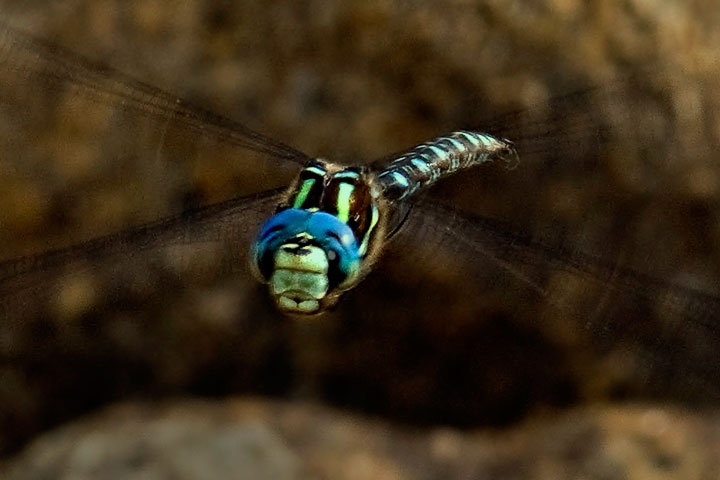 This is a male Paddle–tailed Darner (Aeshna palmata). It is distinguishable from the Shadow Darner by the black horizontal line across its face.
This is a male Paddle–tailed Darner (Aeshna palmata). It is distinguishable from the Shadow Darner by the black horizontal line across its face.
This dragonfly is almost always encountered during its rapid flight along the margins of the Lake (which makes it difficult to photograph). The two (blue) eyes touch along a central line. Apparent in this picture is a characteristic common to all dragonflies: unlike most insects, the dragonfly doesn’t move its front and back wings together: when the front wings are down, the back are up. ID by RAC
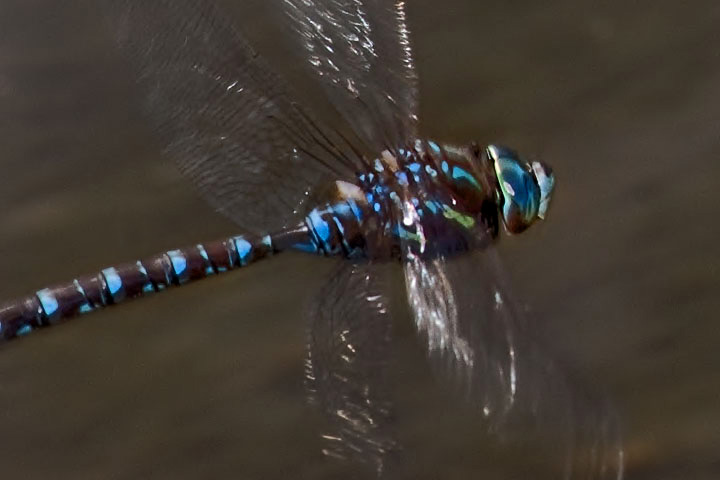 A male Shadow Darner patrols the shoreline for food and mates. Its body is mainly black with blue spots, but there is yellow on the thoratic stripes and face.
A male Shadow Darner patrols the shoreline for food and mates. Its body is mainly black with blue spots, but there is yellow on the thoratic stripes and face.
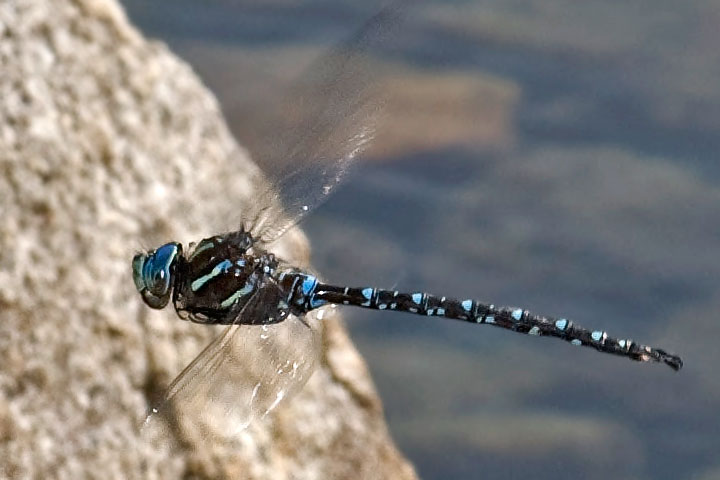 I usually see the male Shadow Darner near a sun-warmed sloping surface such as a pile of rocks.
I usually see the male Shadow Darner near a sun-warmed sloping surface such as a pile of rocks.
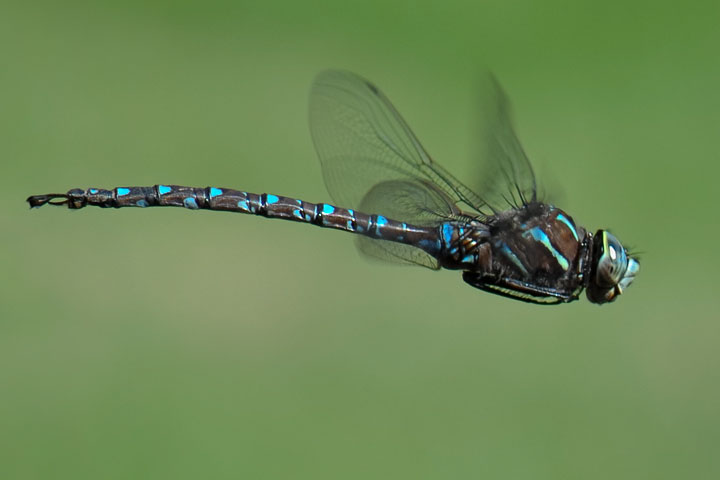 Another male Shadow Darner (Aeshna umbrosa). When it flies, it tucks its legs up to reduce drag. The lack of extensive blue on the top of the last abdominal segment (S10) confirms that this is a shadow darner not a paddle-tailed darner. ID by DP
Another male Shadow Darner (Aeshna umbrosa). When it flies, it tucks its legs up to reduce drag. The lack of extensive blue on the top of the last abdominal segment (S10) confirms that this is a shadow darner not a paddle-tailed darner. ID by DP
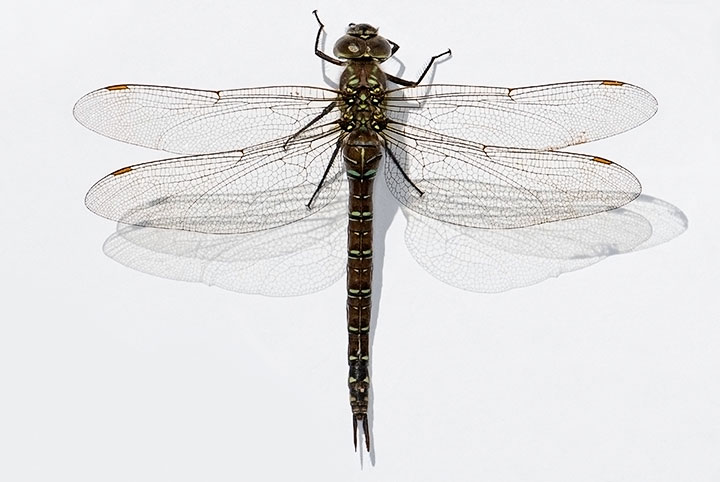 This is a female Shadow Darner (Aeshna umbrosa). Although clearly a darner (the eyes touch), at first I thought this was a different species, but the Shadow Darner shows a clear sexual dimorphism.
This is a female Shadow Darner (Aeshna umbrosa). Although clearly a darner (the eyes touch), at first I thought this was a different species, but the Shadow Darner shows a clear sexual dimorphism.
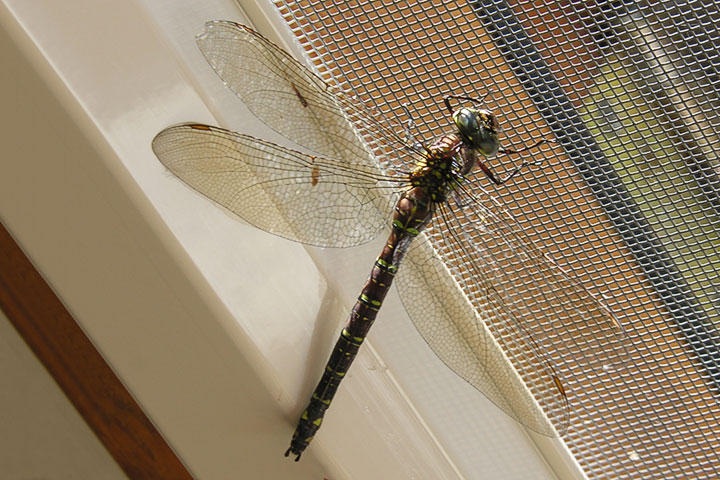 The Shadow Darner is so named because it is also comfortable in the shady woods. This may account for the fact that this is the only type of dragonfly which enters my home when the door is left ajar.
The Shadow Darner is so named because it is also comfortable in the shady woods. This may account for the fact that this is the only type of dragonfly which enters my home when the door is left ajar.
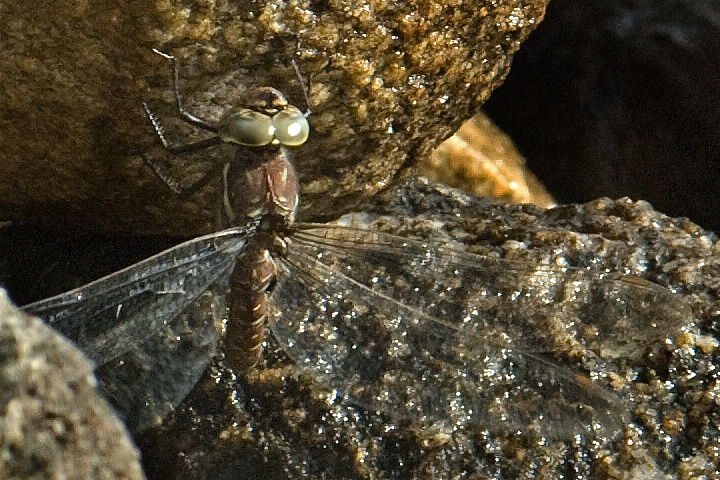 This female Shadow Darner was patrolling the lakeshore and has briefly stopped to perch on a rock.
This female Shadow Darner was patrolling the lakeshore and has briefly stopped to perch on a rock.
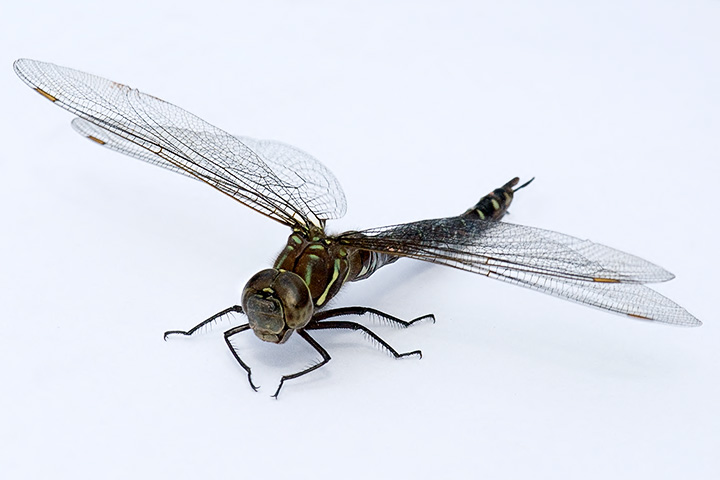 The subdued colours of the female Shadow Darner probably serve to camouflage.
The subdued colours of the female Shadow Darner probably serve to camouflage.
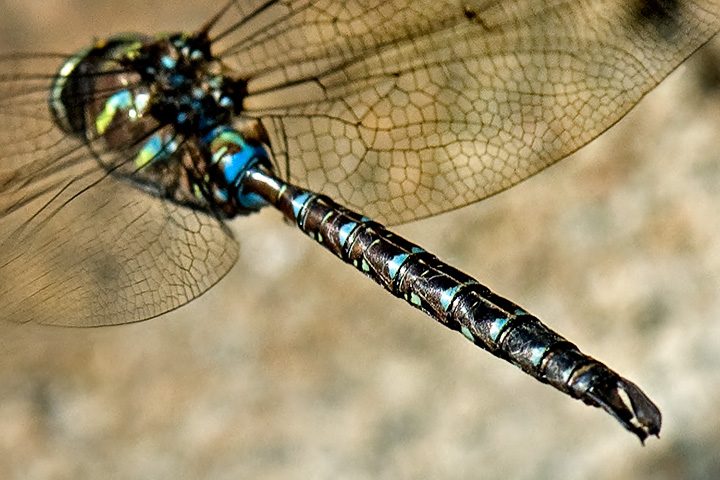 The tip of the abdomen of the male Shadow Darner contains three appendages. The two upper, and lateral ones (the cerci) are used to clasp the female behind the neck, while the lower central one (epiproct) extends across her face, but sometimes damages her eyes. ID by DP
The tip of the abdomen of the male Shadow Darner contains three appendages. The two upper, and lateral ones (the cerci) are used to clasp the female behind the neck, while the lower central one (epiproct) extends across her face, but sometimes damages her eyes. ID by DP
 This female Shadow Darner likely shows mating scars. During mating, the male dragonfly grabs the female by the top back of her head using appendages (cerci and epiproct) at the end of his abdomen. Among darners, spines on those appendages often damage the female’s eyes—likely the origin of the damage seen here.
This female Shadow Darner likely shows mating scars. During mating, the male dragonfly grabs the female by the top back of her head using appendages (cerci and epiproct) at the end of his abdomen. Among darners, spines on those appendages often damage the female’s eyes—likely the origin of the damage seen here.
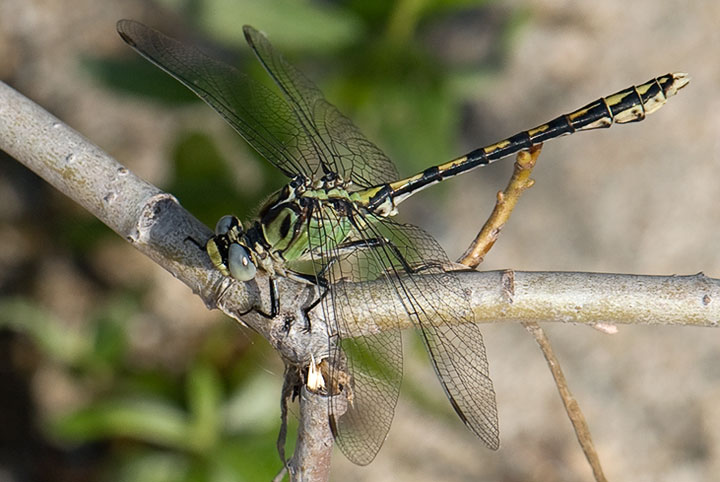 This is a male Pale Snaketail. The eyes are clearly separated, and the enlarged clubtail is apparent. The evidence for this being a male is in the detail below, left. ID by RAC
This is a male Pale Snaketail. The eyes are clearly separated, and the enlarged clubtail is apparent. The evidence for this being a male is in the detail below, left. ID by RAC
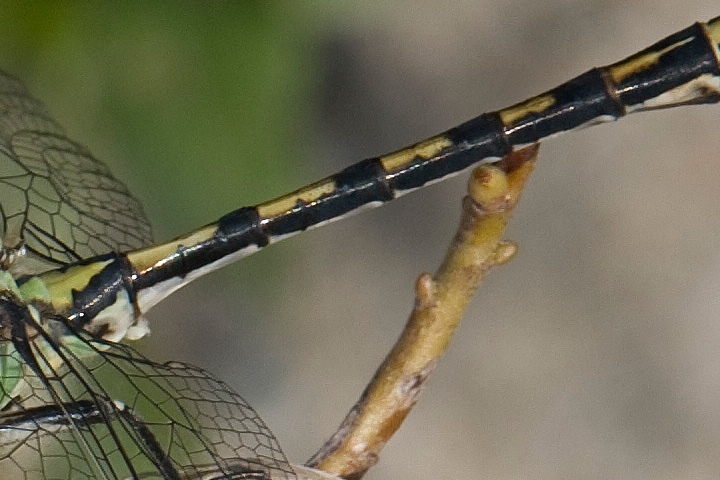 A detail of the abdomen of a male Pale Snaketail. It is quite thin (compare with female, below). Also, the secondary male genitalia are seen as the slight bump on the bottom of the leftmost abdomen segment (look between the wings).
A detail of the abdomen of a male Pale Snaketail. It is quite thin (compare with female, below). Also, the secondary male genitalia are seen as the slight bump on the bottom of the leftmost abdomen segment (look between the wings).
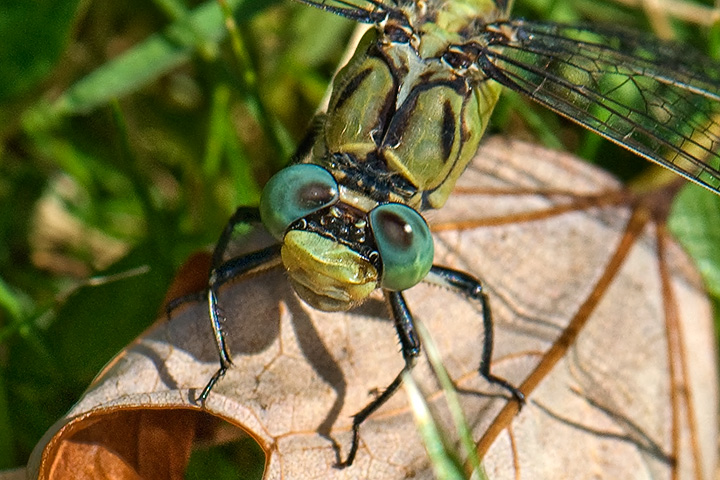 A female Pale Snaketail looks up at the camera with its two compound eyes (oculi) and three simple eyes (ocelli).
A female Pale Snaketail looks up at the camera with its two compound eyes (oculi) and three simple eyes (ocelli).
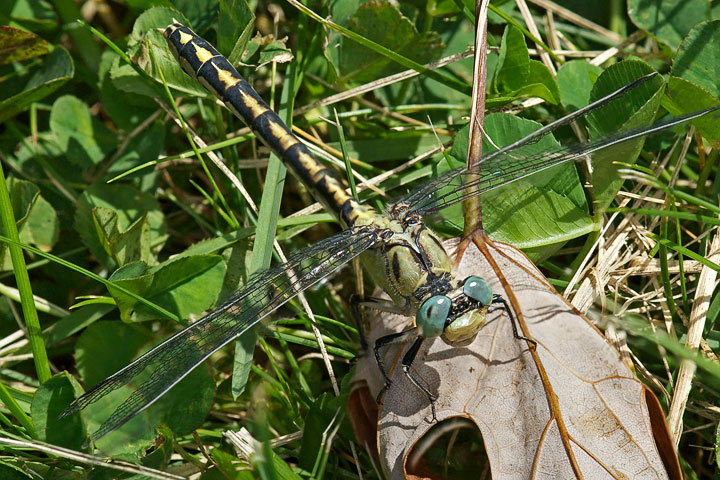 The female Pale Snaketail has a more cylindrical abdomen than does the male.
The female Pale Snaketail has a more cylindrical abdomen than does the male.
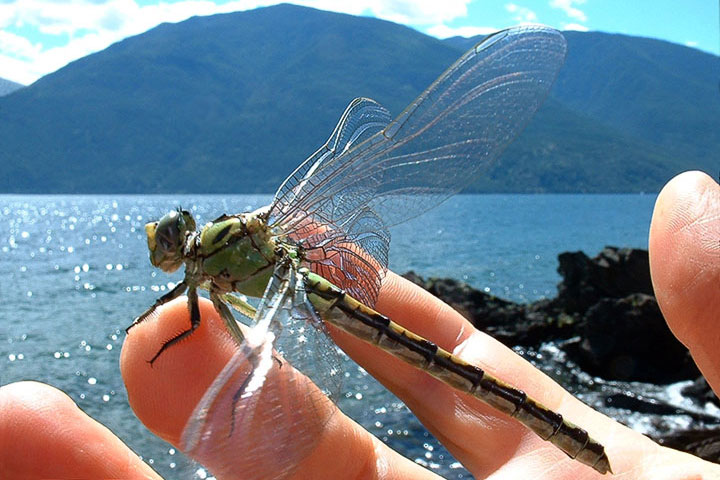 The clubtail dragonfly (this is a female Pale Snaketail) is more inclined to hunt from a perch than from the wing. It clearly is willing to perch almost anywhere.
The clubtail dragonfly (this is a female Pale Snaketail) is more inclined to hunt from a perch than from the wing. It clearly is willing to perch almost anywhere.  Doug Thorburn.
Doug Thorburn.
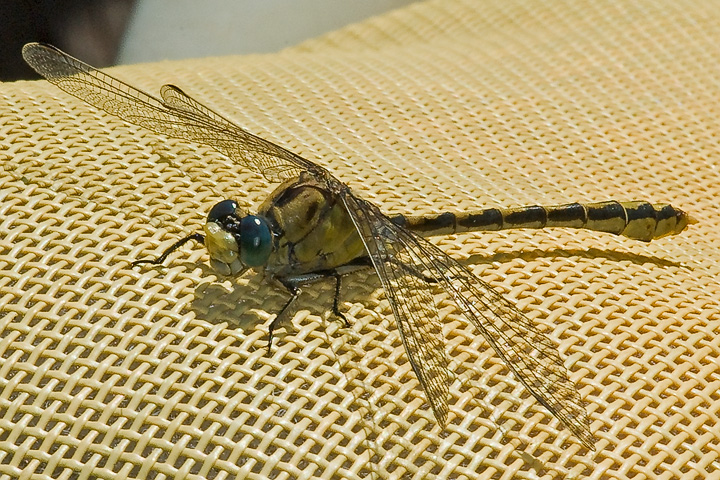 This shot of a male Pale Snaketail may seem like just another picture of a clubtail. However, this observation was made in late October, and prior to it, the belief was that the flight period in British Columbia for this insect ended mid September. So, this picture set a record for the Province. ID by RAC
This shot of a male Pale Snaketail may seem like just another picture of a clubtail. However, this observation was made in late October, and prior to it, the belief was that the flight period in British Columbia for this insect ended mid September. So, this picture set a record for the Province. ID by RAC
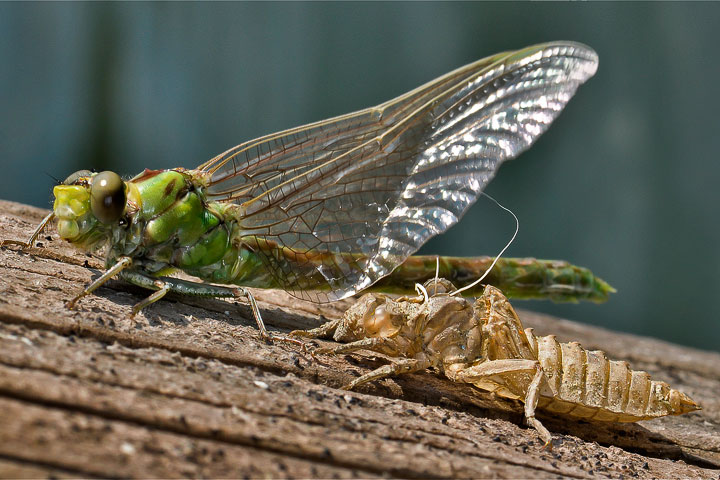 It is early August and a female Pale Snaketail has just emerged from the nymph stage. ID by RAC
It is early August and a female Pale Snaketail has just emerged from the nymph stage. ID by RAC
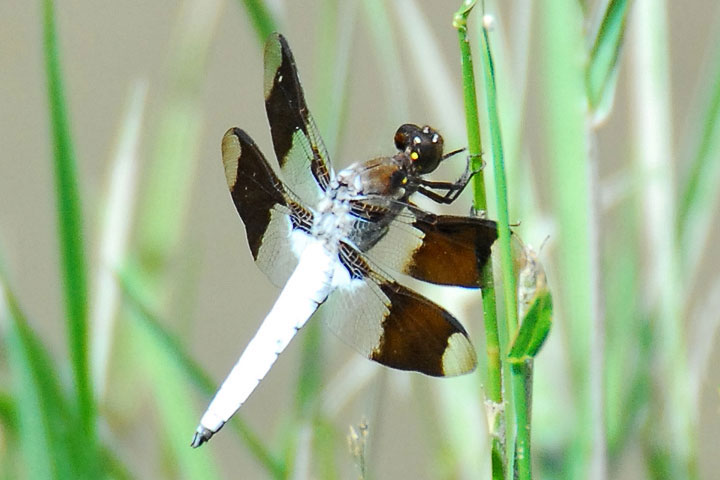 The Common whitetail is found around ponds, streams, and marshes where it hawks for mosquitoes and other small insects. Each of these pictures shows a male; the female has the same wing pattern, but has a brownish abdomen.
The Common whitetail is found around ponds, streams, and marshes where it hawks for mosquitoes and other small insects. Each of these pictures shows a male; the female has the same wing pattern, but has a brownish abdomen.
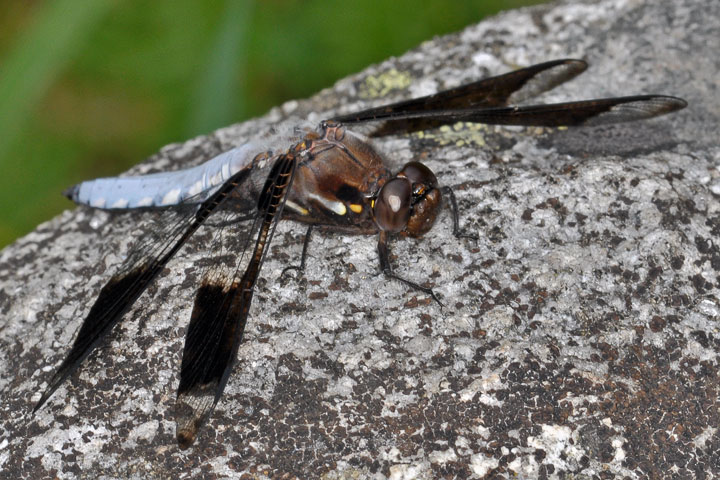 As visitors to the lakeside go, the Common whitetail is actually not all that common.
As visitors to the lakeside go, the Common whitetail is actually not all that common.
 The striking wing patterns and white tail make the Common whitetail unmistakeable. It may have settled on this bolder because it was warm rather than because it provided a good perch to hawk smaller insects.
The striking wing patterns and white tail make the Common whitetail unmistakeable. It may have settled on this bolder because it was warm rather than because it provided a good perch to hawk smaller insects.
Identifications:
RAC = Robert Cannings
DP = Dennis Paulson
Information from Living Landscapes: The Dragonflies of the Columbia Basin (includes damselflies), and from the Royal BC Museum: The Blue Darners in British Columbia.
![]()